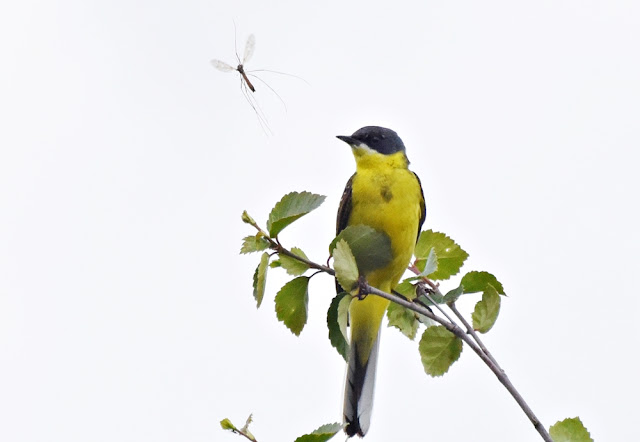 |
| A Yellow Wagtail Motacilla flava eyes off a crane fly Tipulidae |
As a final post on my recent trip to Norway, I would like to mention the insects, the profusion of insects which make it possible for so many migrant birds to breed in the tundra and birch forests. The most noticeable insects are the mosquitoes, of which there are thousands, millions, and all the females are intent on sucking blood. This is probably the most deterring factor for me to visit the arctic, but for the birds it is perhaps the most alluring factor. And many other insect species also thrive in high numbers, all adding up to form the rich feeding grounds for birds to rear their chicks. Of course, on balance, it is worth the discomfort to study the birds.
 |
| Mosquitoes torment a Short-eared Owl Asio flammeus chick |
However, not all birds eat insects. The owls eat voles and have to endure the mosquitoes like we humans.
 |
| Male Red-spotted Bluethroats Luscinia svecica are one of the more conspicuous birds in the birch forests they often perch on on high perches when hunting for insects |
The most obvious and abundant passerines feeding on the insects are the Yellow Wagtails, Red-spotted Bluethroats and Willow Warblers Phylloscopus trochilus. However, in some years the weather can be cold and insects scarce. Then the passerines are scarce too, as so often happens with bonanzas, it can be a case of boom or bust. The migrant birds clearly take a risk in flying so far north to breed, but the risk must be worth taking or else evolution would have selected against such behaviour.
 |
| Female Red-spotted Bluethroats are one of the less conspicuous birds in the birch forest when they hide on their nests |
The waders also rely on the insects. The adults eat them, often probing for the larvae, and the chicks eat them, often as adults, picking emerging mosquitoes as they lie on the water surface. If only they could eat a few more mosquitoes before they eat me. But now that I am back south and away from the mosquitoes, birch flies and horse flies, I have cast them out of my thoughts. I can now concentrate on the good memories; the wealth of flora and fauna in arctic Norway. That was a great trip.
 |
| Wood Sandpipers are very conspicuous when they have young. They often stand on high perches overlooking the mires where their chicks are feeding - even in the rain |

No comments:
Post a Comment